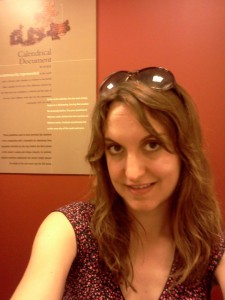Every year a handful of students choose the Cultural Policy Option of the MAPH program. Jane Hanna writes about her experience in MAPH, the Cultural Policy and her really cool job at the Field Museum.
How were you involved in the Cultural Policy Center?

I worked as a Graduate Research Assistant in CPC while I completed the Master of Arts Program in the Humanities in 2010-11. As a MAPH student, I chose the Cultural Policy option, and much of my coursework was taken at the Harris School and Law School. I was looking for an academic program which would allow me to have an interdisciplinary focus, combining my interest in the arts and humanities with my career experience in marketing, and assist me in my aspirations towards a career in museum administration. I’m also a technologist and gamer and my research areas included mobile and social media and the ways in which these complicate traditional museum exhibition, education, and marketing strategies. At CPC, I helped with the preparations for the CultureLab Emerging Practice Seminar 2011, which was focused in part on engaging arts audiences through the use of technology.
Additionally, I was involved with the lunchtime workshop series as both an employee of CPC and an enthusiastic attendee. After graduating, I also participated in the marvelous Future of the City: The Arts Symposium by virtue of my association with CPC. Betty Farrell served as my supervisor as well as my thesis advisor and professor.
What do you do now?
I am the Social Media Strategist for The Field Museum of Natural History here in Chicago. In this capacity, I am responsible for maintaining a broad and ever-growing portfolio of social media pages for the Museum, including Facebook, Twitter, Google+, LinkedIn, FourSquare, Flickr, YouTube, Vimeo, Yelp, and many more. I work closely with the scientific staff to develop engaging content that educates and entertains our digital community of fans and supporters.
I also deliver up-to-the-minute news about exhibitions, educational programs, special events, and promotions to the public several times per day, seven days per week. I monitor and evaluate the performance of these pages using Google Analytics and other tracking tools, and continually look for short- and long-term ways through which the Museum can leverage these properties for various strategic purposes. I think I have one of the best jobs at the Field not only because I am uniquely positioned to collaborate with staff working in all of the Museum’s departments, but also because I spend a large portion of my time interacting with our enthusiastic public, answering their questions, inviting them to participate in dialogues and citizen scientist activities, and learning valuable insights from their feedback.
How did your time at the CPC help you prepare for your current position?
Working as a marketing manager I knew that business decisions must be backed in data. This can be tricky in the nonprofit sector, because customers aren’t necessarily consuming products and it’s impossible to act strategically when you don’t know how to measure the value of what you do. I was starting to feel a little bit like an alien in both my professional and academic lives. My fellow humanists looked at me in horror whenever I wanted to talk about statistics, measurement, data–protesting that art cannot be quantified. And policy analysts had little time for conversations about the arts and humanities, the presupposition being these were matters of the soul and thus too slippery to accurately to view through an econometric lens and therefore not worth the time. CPC was an oasis of like-minded people from across disciplines. The consultants involved with CultureLab, including Allan Brown, Peter Linett, and Roger Tomlinson, along with the U of C faculty who teach in the MAPH Cultural Policy option–Betty Farrell, Don Coursey, and Lawrence Rothfield–gave me a powerful set of tools for answering the both the artists and analysts alike. Every single day, I am called upon to demonstrate the value of what I do to a wide range of audiences; from the Board of Directors to the media to the curatorial staff. I can speak to the PhDs in our scientific enterprise using an academic vocabulary to explain the power of social media to disseminate knowledge and encourage mindshare and collaboration within disciplines; I can speak to the marketing team about the ROI (return on investment) of various Facebook campaigns; I can speak to the education staff about content that connects scientific stories with the public in very powerful and personal ways–and I can do all of that because I have a firm understanding of the data: what to track, how to track it, how to interpret it, and how to make strategic decisions and adjust policies based on results. All of that is possible because of the robust education I received through CPC and associated coursework. Moreover, the connections I was able to make to various movers and shakers in the Chicago cultural field have been absolutely invaluable. Indeed my first job at The Field Museum was a very prestigious internship, working directly for President John McCarter–an opportunity which came to me directly as a result of having been a graduate student in Cultural Policy. From there I was able to move into my current position–truly my dream job at my dream institution–due in large part to my thesis work on social media, and the experience and skills I learned during my time at CPC. I am truly grateful to have found a group of fellow aliens, and am still overwhelmed by the marvelous opportunities that I’ve enjoyed through CPC.
Leave a Reply